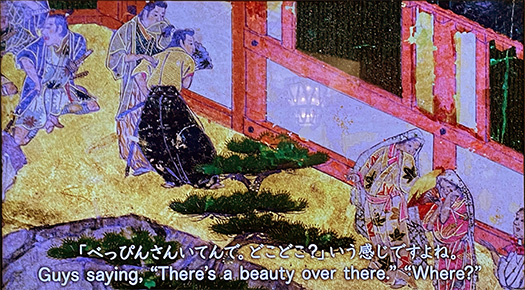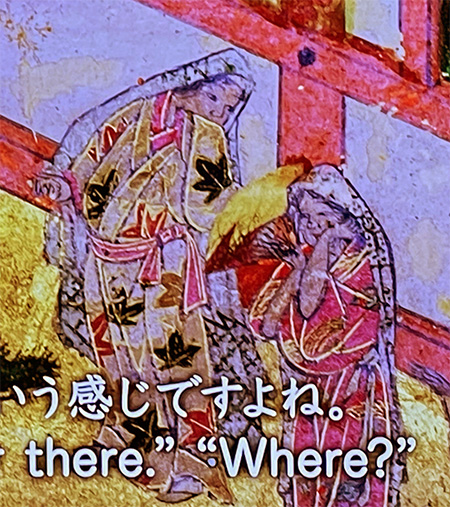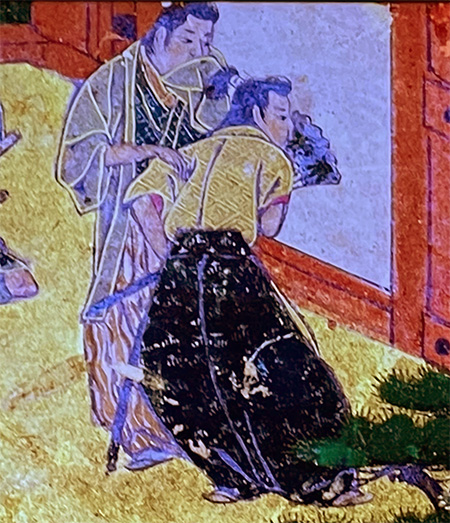


この図は、岩佐又兵衛作「洛中洛外図・舟木本」のひとこま。
高精細な画像解析で、そのディテールがクッキリと浮かび上がってきてたいへんオモシロい。洛中洛外図というのは一種の「映画」のような総合芸術であって、多くの人が興味を持つ「都のにぎわいはどんなだろうか」テーマを細部の「風俗情報」まで含めて画業として仕上げる日本独自の芸術ジャンル。
織田信長が越後の上杉謙信を懐柔籠絡するのに、謙信が若い時期に京都を訪れていて、そのことがかれの精神に深く根を下ろしていると判断して、洛中洛外図を製作させて贈与したことが知られている。
「あなたが昔、愛していた京都の街のイマドキはこんなになっていますよ。事実上支配しているのはわたしですから、友好関係で行きましょう。武田信玄なんか、やっつけちゃいましょうよ」と働きかける重要なツールになったというのです。
信長のことだから、謙信がどういうふうに京の街で過ごしていたかも入念に調べ上げて、「おお、昔行ったあの場所はいまこんなふうになっているのか(興味津々)」と手懐けられていったことでしょう。
謙信は結構律儀で一本スジな性格なので、「無二の関係で行こう」となって、対信玄対策で織田軍との連携を一時期は強めていたことが知られている。信長の奸計にハマったと言えるだろう。ただし、やがて破綻して交戦状態になっていくけれど、そのときは武田の危険性も大きく低下していたので信長としては一定の余裕があったと思う。
そういう歴史のなかでの役割を果たした洛中洛外図ですが、この舟木本作者の岩佐又兵衛は、歴史の中の人間として一度会ってみたいなと思う人物。荒木村重の妾腹の男子として武家に生まれたけれど、やがて絵師という自由業になって、こういう作品を生み出し、さらに江戸に行って浮世絵の草創にも関わったとされている。雑誌という表現手段について事業をしてきた人間として、なにか心に掛かってくる人物。
この絵柄ではなんと、京都市中のある辻で若サムライが、ベッピンさんに「ナンパかけようか、どうしようか」と談合している様子と、一方、姫様のお付きの女房がそういう男たちをしっかり品定めして、「これなら姫さんもまんざらでもなさそうだし、ナンパかけてきたらひとつ縁をつながせてみるか」みたいな悪だくみ表情を見せている。
この戦国末・江戸初期の時代の開放的な時代相が端的に見えてくる。お姫さまも「頬を赤らめる」ほどに「お、ちょっといいかも」という反応を見せている。
総合芸術としての1コーナーですらこういう「物語性」を観察し表現する人間観に共感を覚える。
こういう表現力、表現領域というものは、同時代の西洋や中国などのアジア世界でも特異なものだったのではないだろうか。イマドキの「大衆芸能」感覚に近い分野への天才が発揮されているように思ってしまいます。
English version⬇
Street corner in Kyoto in the early Edo period, with men and women “picking up women”.
The early Edo period was filled with a much more open and free atmosphere than the mid-Edo period or later. The universal human feeling of love is beautifully depicted. …
This is a scene from “Rakuchu Rakugai-zu, Funaki version” by Matabei Iwasa.
It is very interesting to see the details clearly come to life through high-definition image analysis. Rakuchu-Rakugai-zu is a kind of comprehensive art like a “movie,” a uniquely Japanese genre of art in which the theme of “what the bustle of the capital is like,” which is of interest to many people, is made into a work of art, including detailed “information on customs and manners.
It is known that Nobunaga Oda, in his efforts to win over Kenshin Uesugi of Echigo, had Kenshin visit Kyoto when he was young, and judging that his spirit was deeply rooted in the city, he had him produce and give him the Rakuchu-Rakugaizu (Scenes in and around Kyoto). He is known to have had a map of the city of Kyoto made and given to him, judging that his spirit was deeply rooted in the city. I am the de facto ruler of Kyoto, so let’s have friendly relations. Let’s go on friendly relations and defeat Shingen Takeda.
Nobunaga must have carefully studied how Kenshin was spending his time in Kyoto, and he must have been intrigued to know that the place he had visited so long ago was now like this.
Kenshin is known to have been quite disciplined and single-minded, so he decided to “go with a non-partisan relationship” and strengthened his cooperation with the Oda forces for a time as a countermeasure against Shingen. It can be said that Nobunaga’s wiles fell into place. However, it eventually collapsed and the two sides entered into a state of war, but at that time, the danger to Takeda had greatly diminished, so Nobunaga had a certain amount of leeway.
The Funaki book author, Iwasa Matabei, is someone I would like to meet once as a person in history. He was born into a samurai family as the son of a concubine of Araki Murashige, but eventually became a free-lance painter and created these works, and it is said that he also went to Edo and was involved in the creation of Ukiyoe. As someone who has been involved in the business of magazines as a means of expression, something about this man is very interesting to me.
In this picture, a young samurai is discussing with a beppin-san at a street in Kyoto, asking whether he should pick her up or not, while the wife of the princess is assessing the men and says, “Well, she doesn’t look too happy about this, so if she tries to pick him up, I’ll try to make a connection with her. If they try to pick up on her, I’ll try to make a connection with her.
The openness of the period at the end of the Warring States period and the beginning of the Edo period is clearly visible in this scene. The princess also shows a “blush on her cheeks” as she responds, “Oh, that’s kind of nice.
I feel sympathy for the human viewpoint that observes and expresses this kind of “narrative” even in one corner as a comprehensive art form.
This kind of expressive power and domain of expression must have been unique in the West, China, and other Asian countries of the same period. I can’t help but think that he is displaying a genius for a field that is similar to the “popular entertainment” sense of the Imadaki era.
Posted on 3月 25th, 2024 by 三木 奎吾
Filed under: 「都市の快適」研究







コメントを投稿
「※誹謗中傷や、悪意のある書き込み、営利目的などのコメントを防ぐために、投稿された全てのコメントは一時的に保留されますのでご了承ください。」
You must be logged in to post a comment.